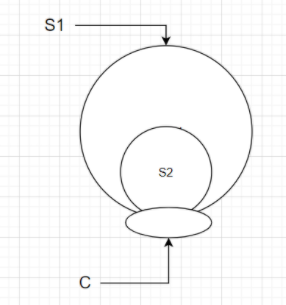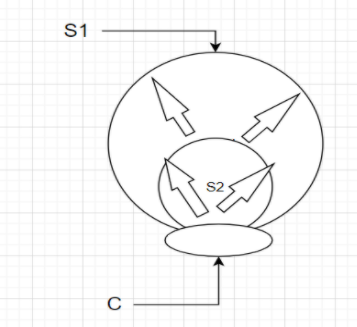
Consider two surfaces $S_1$ and $S_2$ sharing the same open circular boundary as shown in the figure. If \[{{{\theta }}_{{S_1}}}\] and \[{{{\theta }}_{{S_2}}}\]are magnetic flux through these surfaces then,

(A) \[{{{\theta }}_{{S_1}}} > {{{\theta }}_{{S_2}}}\]
(B) \[{{{\theta }}_{{S_2}}} > {{{\theta }}_{{S_1}}}\]
(C) \[{{{\theta }}_{{S_2}}} = {{{\theta }}_{{S_1}}}\]
(D) \[{{{\theta }}_{{S_1}}} = {{{\theta }}_{{S_2}}}\]

Answer
442.8k+ views
Hint: Magnetic flux is the number of the magnetic field passing through a closed surface. The measurement of the magnetic field actually provides the total magnetic field that passes through a given surface area.
Complete step by step answer:

Case 1:
Since nothing is mentioned about the presence of any magnetic field producing element inside the surfaces, even if we consider C to be a closed boundary we know that that \[\phi = \oint {\overrightarrow {B.} } \overrightarrow {dS} \] but without the presence of any magnetic field producing element within the closed surface we get $\overrightarrow B = 0$ and hence the value of flux = 0
\[{{{\theta }}_{{S_1}}} = {{{\theta }}_{{S_2}}} = 0\]
Case 2:
Now we consider that some flux is entering through the opening which is being shared by both the surfaces $S_1$ and $S_2$ we can notice that,
The flux that is passing through C and going through surface $S_2$ will also pass through surface $S_1$ so the flux passing through both surfaces is the same and equals net flux entering through their common circular boundary.
If we start from calculating the flux coming to $S_1$ then also we can notice that whatever the amount of flux is coming to $S_1$ that flux has come from nowhere else but the surface $S_2$. So by this approach also we can conclude that net flux passing through both the surfaces will be equal.
\[{{{\theta }}_{{S_1}}} = {{{\theta }}_{{S_2}}} = 0\]
Hence, the correct answer is option (D).
Note: In order to tackle such kinds of questions one should have understanding knowledge of the various terms involved and the application of Gauss's law. Students should have to practice a lot of numerical problems based on the application of Gauss law to master the concept behind the problems.
Complete step by step answer:

Case 1:
Since nothing is mentioned about the presence of any magnetic field producing element inside the surfaces, even if we consider C to be a closed boundary we know that that \[\phi = \oint {\overrightarrow {B.} } \overrightarrow {dS} \] but without the presence of any magnetic field producing element within the closed surface we get $\overrightarrow B = 0$ and hence the value of flux = 0
\[{{{\theta }}_{{S_1}}} = {{{\theta }}_{{S_2}}} = 0\]
Case 2:
Now we consider that some flux is entering through the opening which is being shared by both the surfaces $S_1$ and $S_2$ we can notice that,
The flux that is passing through C and going through surface $S_2$ will also pass through surface $S_1$ so the flux passing through both surfaces is the same and equals net flux entering through their common circular boundary.
If we start from calculating the flux coming to $S_1$ then also we can notice that whatever the amount of flux is coming to $S_1$ that flux has come from nowhere else but the surface $S_2$. So by this approach also we can conclude that net flux passing through both the surfaces will be equal.
\[{{{\theta }}_{{S_1}}} = {{{\theta }}_{{S_2}}} = 0\]
Hence, the correct answer is option (D).
Note: In order to tackle such kinds of questions one should have understanding knowledge of the various terms involved and the application of Gauss's law. Students should have to practice a lot of numerical problems based on the application of Gauss law to master the concept behind the problems.
Recently Updated Pages
Glucose when reduced with HI and red Phosphorus gives class 11 chemistry CBSE

The highest possible oxidation states of Uranium and class 11 chemistry CBSE

Find the value of x if the mode of the following data class 11 maths CBSE

Which of the following can be used in the Friedel Crafts class 11 chemistry CBSE

A sphere of mass 40 kg is attracted by a second sphere class 11 physics CBSE

Statement I Reactivity of aluminium decreases when class 11 chemistry CBSE

Trending doubts
10 examples of friction in our daily life

Difference Between Prokaryotic Cells and Eukaryotic Cells

One Metric ton is equal to kg A 10000 B 1000 C 100 class 11 physics CBSE

State and prove Bernoullis theorem class 11 physics CBSE

What organs are located on the left side of your body class 11 biology CBSE

Define least count of vernier callipers How do you class 11 physics CBSE




